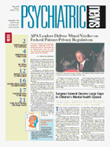A new study utilizing magnetic resonance imaging (MRI) of the thalamus during a first episode of psychosis has pinpointed differences in the size of the brain’s main sensory filter, from the earliest stages of schizophrenia. The findings may help to explain why people with schizophrenia experience profound confusion during their illness.
The study, published in the January American Journal of Psychiatry, was led by Tonmoy Sharma, M.R.C. Psych., at London’s Institute of Psychiatry. Sharma studied 67 individuals, 38 of whom were experiencing their first episode of psychosis; the remaining 29 were healthy volunteers with no history or evidence of psychiatric illness. In contrast to most other studies, 13 of Sharma’s patients with schizophrenia had little or no experience with any antipsychotic medication. Of those who were taking medication, the average duration of drug therapy was only 4.6 weeks.
Most previous research of the thalamus studied chronically ill patients. Although prior studies have identified many regions in the brain affected by schizophrenia, those looking at the thalamus have largely been inconclusive or contradictory. Postmortem studies have identified decreases in the volume of the thalamus and the number of neurons in the mediodorsal thalamus.
Sharma and his colleagues wanted to look at thalamic size in a group of patients who were early in the course of their illness, hoping also to study patients who were naïve to the effects of antipsychotic medications. Sharma’s group hypothesized that patients would have smaller thalamic volumes than nonpsychotic comparison subjects.
The investigators found that total thalamic volume in the patients with schizophrenia was, on average, 5.5 percent smaller than in the healthy comparison subjects. No differences were noted between the two sides of the thalamus or between sexes. Significantly, no differences in thalamic volume were seen in the comparison of patients receiving antipsychotic medications with medication-naïve patients—both patients who had received antipsychotic medication and medication-naïve patients had reduced thalamic volumes. Thalamic volumes did not correlate significantly with the positive, negative, or global symptom scales, duration of treatment, or duration of illness.
“This study reveals that there is a fundamental problem in the hub of the brain,” said Sharma. “If you think of the brain in terms of networks, it is like making a phone call when the line is not connected properly; the call can’t be made, or you may get through to the wrong person. It is the same in the brain. If there are problems with the connections, information will not be passed to the correct regions. The ability to filter and process information is vital for leading a normal life.”
The current findings, along with other work by Sharma’s team showing decreases in gray matter in patients with early stages of schizophrenia, may suggest a role for brain imaging in pinpointing early warning signs for the illness.
Sharma’s study, “Magnetic Resonance Imaging of the Thalamus in First-Episode Psychosis,” can be accessed on the Web at www.psychiatryonline.org by clicking on AJP and then the January issue. ▪
